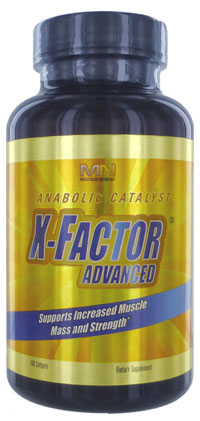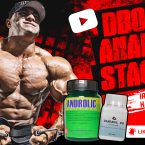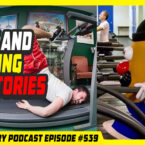Sign up to Get FREE Steroids, SARMS, Peptides eBooks
[sc:masthead-std]
[sc:salutation-std]
This is definitely worth the read! Today I’m sitting down to speak with a man that probably won\'t need an introduction. William Llewellyn is the head chemist at Molecular Nutrition, and also author of ANABOLICS, the “go-to” guide on steroids and other performance-enhancing substances. Llewellyn is widely regarded as a leading expert on this subject. ESPN even put him on the cover of their magazine several years back, writing that, “Llewellyn represents a pill-pushing culture in which muscle-building drugs are increasingly viewed as an inevitable part of competition.” While a little harsh, he does indeed consult with high profile athletes, and specialize in the science of human performance enhancement.
Knowing him a long time though, he is also a strong advocate of health and safety. William happens to be an old friend of mine. A recent get-together provided a great opportunity to catch up on the often-salacious world of doping. We covered some hot topics… Oscar Pistorious… Lance Armstrong… the international doping scene in general... William’s pick for most effective and toxic steroids. He even names the agent most critical to the success of his athletes. You don’t want to miss it!
 George: I’m going get right to it with a big question. Like me, many people are fans of professional sports. Just how common is it for an athlete to dope these days?
George: I’m going get right to it with a big question. Like me, many people are fans of professional sports. Just how common is it for an athlete to dope these days?
William: It depends on the sport, but in general it is a lot more common than people think. In just about any sport where speed, strength, or endurance plays a role in the outcome, you are likely to find doping. The more money or reward involved in the sport, the more incentive there is to dope. This is just human nature I think. Many high-profile sports do have strong drug testing programs. This doesn’t necessarily eliminate doping, however. For many competitors, it just presents another challenge.
George: Can you tell our readers how people get away with doping when there is drug testing?
William: It all depends on the testing. Some sports, I don’t want to name them, still have what I’d consider “PR” testing policies. These are not designed to catch athletes. They are designed to present a public image the sport is against doping. In these sports the athletes generally know what is being looked for and what is not. They may also be notified in advance of the date, and therefore when they have to “go off”. Doping remains somewhat casual in some sports. Other sports are much more serious about testing, many working closely with the World Anti-Doping Agency. I don’t want to reveal too much. Let’s just say some fairly effective anabolic drugs are still invisible to many urine tests.
George: What about testing at the Olympic level?
William: The most sophisticated type of testing is called Biological Passport. This involves fingerprinting the health markers of an athlete over time. They look for things out of place that may suggest doping. For instance, you could get flagged if a hormone such as LH (luteinizing hormone) was suppressed when it shouldn’t be. This could suggest steroid use, even if they cannot find the steroid. In passport sports, you can still get away with low doses of certain anabolic substances so long as they are natural to the body and you are consistent with their use. Of course, as you work your way up the ranks of any sport you are likely to be faced with much lighter testing. Biological passport is very expensive and rarely used, overall.
George: So in your view, the level playing field is a myth?
William: It depends on how you define level playing field. If you define it as a sport devoid of people taking banned substances, there are few in my experience. I do think it is a myth. Others may define level playing field as everyone passing the same urine screen. As someone on the inside of sport I respect the goal of fair drug-free competition, but also acknowledge the unrealistic nature of this objective at present. Thinking only of the ideal, the fair field where doping doesn\'t exist, is daydreaming. I don’t advocate doping, but I am a realist.
 George: How about a hot media topic. Oscar Pistorius. Many reporters are trying to link steroid use to the horrific killing of his girlfriend. What do you say to someone that believes steroids were the cause?
George: How about a hot media topic. Oscar Pistorius. Many reporters are trying to link steroid use to the horrific killing of his girlfriend. What do you say to someone that believes steroids were the cause?
William: This type of speculation drives me nuts. Steroids are hormones, of course. Aggression and irritability are not uncommon. A small percentage of people do display poor judgment or emotional control. But that is a far cry from homicidal “roid rage”. Steroids do not make people “bad”. Sometimes, however, bad people take steroids. I think it is as simple as that.
George: What did they find in his house? I heard it wasn’t steroids after all.
William: It was a product called Testis compositum N. It is a natural product containing small amounts of herbs and organ extracts like animal heart and testicles. It is not really something I’d put on the top of my list of effective performance-enhancing agents, but it does not appear to be banned. Perhaps this is why he had it. Maybe some people find value in it. I really can’t say.
George: What compounds do you recommend when you consult athletes? Better yet, what one agent has made the most difference?
William: It is not a steroid. Everyone has access to steroids. I can’t really provide any magic advice here. The thing that has made the biggest difference for those working with me is the inclusion of arachidonic acid (ARA) in their programs. Night and day in many cases, regardless if other drugs were used or not.
 George: (For those not familiar, arachidonic acid is an essentially fatty acid, not a drug.) Can you explain why arachidonic acid has been so important?
George: (For those not familiar, arachidonic acid is an essentially fatty acid, not a drug.) Can you explain why arachidonic acid has been so important?
William: The body needs arachidonic acid to initiate protein synthesis. It is critical to the process. Regular training also depletes ARA levels from the muscles. This contributes to training stagnation. With less ARA in the muscle tissues, it gets harder to stimulate growth. Supplementing ARA replenishes these levels. I’ll be the first to tell you that I discovered this role of ARA, and sell it as a supplement. I view my work with ARA as my legacy to this field though, not just business.
George: Some of our readers might be interested in trying arachidonic acid. Can you work out a special offer for them?
William: Of course. Let me work something up and get back to you. I’ll come up with something really good for your guys.
George: Thank you for that. Here is another drug question for you. In your opinion, what is the most effective steroid for gaining muscle? THE strongest steroid.
William: Anadrol (oxymetholone). This is still the king of bulking steroids. I don’t care what crazy potent designer steroid you find; it isn’t stronger than Anadrol at building muscle.
George: I know the risk are overstated, but there are risks. In your opinion what steroid has the greatest potential for health side effects?
William: For a long time my answer to this was also Anadrol. It tends to be associated with strong liver and cardiovascular toxicity. Things like high blood pressure, bad cholesterol, and elevated liver enzymes and stress are consistent. It is not a steroid to be taken lightly. Lately though, I’ve been seeing more use of methyltrienolone (methylated or oral trenbolone). This steroid is exceedingly liver toxic, probably on the cardiovascular system as well. It was actually pulled from market decades ago because of its liver toxicity. It is now back on the black market as a designer steroid. There is even a more toxic cousin of this steroid called dimethyltrienolone, but that one really hasn’t caught on yet. Anadrol kind of looks tame next to these, in my opinion. These are drugs I’d recommend anyone steer clear of. I don’t think it is necessary to mess with such extreme agents.
George: Are there any sports where you’ve seen doping, which might surprise readers? Anything unusual?
William: Good question. Yeah, I think there is a couple. Professional golf and tennis come to mind. Both are sports with a lot of money at stake. Few people think of them as sports with a doping problem, but I can tell you some of these athletes take their performance very seriously. Swimming is another one, but I think the public has been catching on to this.
George: Lance Armstrong finally admitted doping. I take it this wasn’t a surprise to you?
 William: I can’t say it was a surprise, no. I never get surprised when someone admits to or is caught doping in a high-profile sport. A surprise to me would have be someone winning the Tour de France seven times without drugs, especially during those years. EPO, testosterone, cortisone, growth hormone, and traditional blood doping were all very common in cycling. For the same reason, doping does not solely define Armstrong for me. He was still a tremendous athlete, and many of the people he rode against were doing the same.
William: I can’t say it was a surprise, no. I never get surprised when someone admits to or is caught doping in a high-profile sport. A surprise to me would have be someone winning the Tour de France seven times without drugs, especially during those years. EPO, testosterone, cortisone, growth hormone, and traditional blood doping were all very common in cycling. For the same reason, doping does not solely define Armstrong for me. He was still a tremendous athlete, and many of the people he rode against were doing the same.
George: Last month Australia was in the news, a lot of doping scandals over there. Did this surprise you, for a country that has strict laws on steroid use?
William: Honestly, there have been rumors for years that doping is very strong, and lets’ just say organized, in certain sports over there. Rumors are rumors, of course. In my experience a country’s laws bear little relevance to the level of doping inside. The U.S. has probably proven that.
George: I know you’ve consulted with high profile athletes. Any names we’d recognize?
William: I know for a fact you’d recognize a few. You do like to talk sports.
George: But you’re not naming, are you?
William: No, I can’t. I’m sorry. Even though many people come to me for non-drug related information, I’m known as someone with expertise in this area. I wouldn’t want to put that association out in the public. I’ve always respected the privacy of others. I’m sure you understand.
George: Completely. On that note I think we’ll close it up now. We’ve covered some good topics. Thank you very much for sitting down with me to do this.
William: Any time my friend.
[sc:signoff-std]

** Post-Interview Update **
BUY ONE, GET ONE FREE - Molecular Nutrition’s X-Factor Advanced
Molecular has put together a BUY ONE, GET ONE FREE special offer for Elite Fitness members.
While supplies last you’ll receive two bottles of X-Factor Advanced, Molecular Nutrition’s famous arachidonic acid supplement, for the price of just one. Plus, SHIPPING is FREE.
This is enough ARA for a full 50-day anabolic cycle! If you have been noticing slow progress, are stuck on a plateau, or just looking to pack on some muscle, you’ve got to give this a try. There is absolutely no better time to add arachidonic acid to your program than now!
Just follow the link below…
X-FACTOR ADVANCED BOGO SPECIAL OFFER
Enter code MAXELITE during checkout!

** Post-Interview Update **
BUY ONE, GET ONE FREE - Molecular Nutrition’s X-Factor Advanced
Molecular has put together a BUY ONE, GET ONE FREE special offer for Elite Fitness members.
While supplies last you’ll receive two bottles of X-Factor Advanced, Molecular Nutrition’s famous arachidonic acid supplement, for the price of just one. Plus, SHIPPING is FREE.
This is enough ARA for a full 50-day anabolic cycle! If you have been noticing slow progress, are stuck on a plateau, or just looking to pack on some muscle, you’ve got to give this a try. There is absolutely no better time to add arachidonic acid to your program than now!
Just follow the link below…
X-FACTOR ADVANCED BOGO SPECIAL OFFER
Enter code MAXELITE during checkout!



![IronOverload.io Hardcore 67 - [2024] Anadrol (Oxymetholone) to Bulk anadrol](https://www.elitefitness.com/articles/wp-content/uploads/2024/05/IronOverload.io-Hardcore-67-2024-Anadrol-Oxymetholone-to-Bulk-145x145.jpg)

